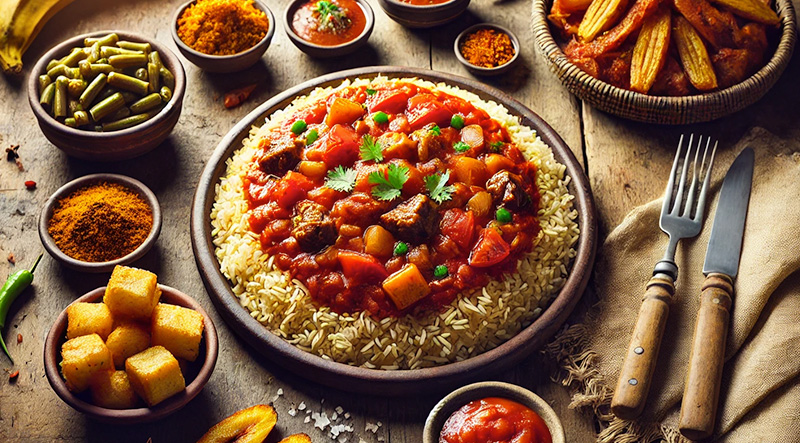Burkina Faso’s beloved national dish, Riz Gras, is a bold celebration of flavor and tradition. Literally meaning "fat rice," this hearty West African classic is anything but ordinary. Simmered in a rich tomato-based sauce infused with onions, garlic, and local spices, the rice soaks up every drop of savory goodness. It's often topped with juicy cuts of meat—chicken, beef, or lamb—and paired with vibrant vegetables like carrots, eggplant, or cabbage, creating a colorful, aromatic feast. Whether served at a festive gathering or a simple family dinner, Riz Gras is more than a meal—it's a taste of Burkina Faso’s warm and soulful culinary heritage. Read More...
Origins Rooted in West Africa: The story of Riz Gras begins with rice itself, a crop that has been cultivated across West Africa for thousands of years. Long before colonialism, indigenous rice varieties such as Oryza glaberrima were grown in the region, particularly in wetter areas. Over time, trade routes introduced new spices, cooking oils, and meats, enriching the region’s culinary diversity.
During the colonial era under French rule, rice became more widespread and integrated into daily cuisine. The term riz gras likely emerged during this period, referencing a rice dish cooked with plenty of oil or meat fat—a prized component in areas where meat was a luxury.
A Dish for Gatherings and Celebrations: Traditionally, Riz Gras is not an everyday meal but rather a dish reserved for special occasions—weddings, religious feasts, or large family gatherings. It’s commonly served in a large communal bowl, encouraging sharing and reinforcing the strong sense of community that is central to Burkinabé life.
The dish typically includes rice cooked in a tomato-based sauce with onions, garlic, and a medley of spices. It’s often accompanied by vegetables like cabbage, carrots, and eggplant, and topped with meat—usually chicken, lamb, or beef—depending on what’s available. The generous use of oil or meat broth gives the rice a rich, savory flavor and a satisfying texture, which is where the dish gets its name.
Regional Variations and Influence: While Riz Gras is a national staple in Burkina Faso, variations of it exist throughout West Africa. In Côte d’Ivoire, a similar dish is called “riz au gras,” and in Guinea, you’ll find “riz sauce.” These variations reflect regional adaptations but share the same culinary DNA—rice enriched with a flavorful base and hearty accompaniments.
Some households add local peppers or fermented seasonings to boost the umami, while others emphasize vegetables or use smoked meat to enhance the dish’s depth. Despite the differences, Riz Gras is consistently associated with hospitality, abundance, and care.
Modern Day Significance: Today, Riz Gras remains a source of pride and cultural identity in Burkina Faso. It’s a staple in restaurants and a must-have at national celebrations. It also serves as a powerful reminder of how food transcends sustenance to become a symbol of unity, resilience, and joy.
In a fast-changing world, Riz Gras continues to anchor Burkinabé families to their heritage—one fragrant, flavorful plate at a time.
Prepare the Meat:
Build the Sauce:
Add Vegetables:
Cook the Rice:
Avoid stirring the rice while it cooks to keep it fluffy.

Serve:
Riz Gras is best enjoyed hot, shared with family or friends from one large platter—Burkinabé style!
Riz Gras, the national dish of Burkina Faso, takes about 1 hour and 5 to 20 minutes to prepare and cook. It begins with browning meat—typically chicken, beef, or lamb—in oil along with onions and garlic, then simmering it in a rich tomato and spice sauce. Vegetables like cabbage, carrots, and eggplant are added and cooked until tender, then set aside while long-grain white rice is simmered in the flavorful broth. Once the rice is perfectly fluffy, the dish is served on a large platter with the meat and vegetables arranged on top, often accompanied by fresh salad or sliced tomatoes for a colorful, communal feast.
A single serving of Riz Gras, approximately 1.5 cups or 350–400 grams, contains an estimated 600 to 750 calories, depending on the ingredients used. The calorie content comes primarily from the rice (about 200–250 kcal), meat such as chicken or beef (150–250 kcal), cooking oil (100–150 kcal), and the rich tomato-based vegetable sauce (around 100 kcal). Using leaner meats, less oil, or increasing the vegetable ratio can slightly reduce the overall calorie count.



